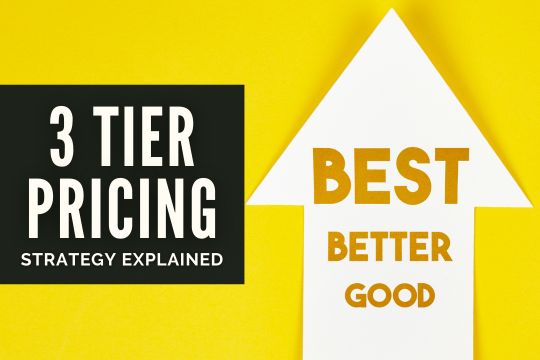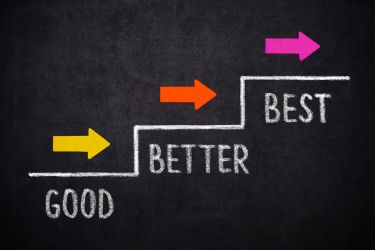
Businesses must balance a lot of competing concerns. For example, business owners want to balance getting the best employees and managing payroll. Businesses want to balance the marketing costs of getting website visitors by turning them into leads. Of course, some balancing acts prove trickier than others. Developing a pricing strategy is often the trickiest of all. You want to maximize profit on your product or service but don’t want to price yourself out of business. To deal with this problem, some businesses adopt a 3-tier pricing strategy. If you’ve never seen the 3 tier pricing strategy explained, keep reading for an overview of the essentials.

A tiered pricing strategy offers customers different options based on different price points. Generally, each successive tier offers more or better versions of a service or product. Video game companies sometimes use a tiered pricing model by offering different game versions. You can get the basic game for the regular price of a game.
You can also get a deluxe version of the game that offers bells and whistles, such as custom items or gear not easily available to regular players. They might also offer a legendary version of the game that includes all the stuff in the deluxe version, plus access to a level or a piece of gear that you can only get by buying the legendary version of the game.
The 3 tier model takes what you can think of as the “good, better, best” approach. The good tier typically offers a fully operational version of the product or service, but you get limited perks or add-ons. The better tier offers a balance between functionality and optional perks. Most businesses consider this the anchor tier. It’s the one that they expect and even wants most customers to pick. You often see the middle tier highlighted with terms like “best value” or “popular.” It encourages customers to pick that one.
The best tier is typically where the product or service comes with every perk or option in place. It’s the most expensive tier but not necessarily the optimal tier for the business. The highest tier almost always means more work for the business because they must often customize the product or provide extra support for the service, which can ultimately cut down on the actual profit you make from it.
The 3 tier model is popular for a reason. The main reason is that it offers you a lot of benefits.

At the top of the list is that you avoid putting customers into a binary, take-it-or-leave-it mindset. That mindset doesn’t work in your favor. Decisive customers just as often pick “leave it” as “take it.” Indecisive customers may not pick at all. Providing options gives the customers an enhanced sense of control over the decision. It changes the dynamic of the decision-making process and puts customers into a mindset of picking the option they like best.
More options can prove as disastrous for a business as too few options. If you give customers 6 or 8 options, it can leave them paralyzed by all the choices. The differences between tiers can blur, leaving them uncertain about which is best. With 3 tiers, the differences between the tiers are usually obvious, if only because of the extra options available at the higher tiers. Most customers can pick with ease between three options.
Tiered pricing can also let customers test out your product without making a full-blown commitment. For example, a business might want to try out a service from a SaaS company to see if its basic functions meet the business’s needs. A tier with a lower price point lets the business do its trial run without necessarily committing to that service. Once the business tries out the software or services, you can often entice them to the more expensive tiers with promises of extended functionalities or more customer support.

With the basic 3-tier pricing strategy explained above, it’s important to realize that many companies treat those tiers as a jumping-off point, not an endpoint. For example, some SaaS companies offer services that partially hinge on the number of users. Let’s say that a company offers a productivity suite. If you plan on using it for a 10-person team, that won’t tax the company's servers offering the service too much. If you plan on using it for 250 people, that puts more pressure on those servers. In cases like that, you may see tiers within tiers based on the total user count.
Email list management services often base their tiers primarily on the number of people on the list. Of course, companies that use this model will often offer optional add-on services to help boost their total revenue. For example, an email list management service might offer you advanced marketing tools or even provide a website builder for an additional fee.
Even with the 3 tier pricing strategy explained, it can prove challenging to develop one that works. You’ll likely need to conduct A/B testing to find the right options and benefits for each tier. Don’t forget to pick your anchor tier and highlight that choice in some way to encourage customers to pick it.
E-Marketing Associates specializes in helping small businesses improve their marketing and grow. Does your pricing strategy work with your current marketing approach? Get a comprehensive marketing report and see how you’re doing.
It offers good, better, best versions at ascending prices, each adding more features or perks.
Businesses spotlight the middle, or anchor, tier because it balances cost and value, steering most buyers toward the price point that maximizes profit while still feeling affordable.
With only three clear options, customers compare fewer variables, understand differences quickly, and feel confident choosing instead of stalling when faced with many similar packages.
The lowest tier lets prospects experience core functionality at minimal cost. After they gain trust and see benefits, you can upsell them to higher tiers promising expanded capabilities or support.
Yes. Firms often layer sub-tiers based on users, volume, or usage. For example, a SaaS plan may have good, better, best levels, each subdivided by seat count or email list size.